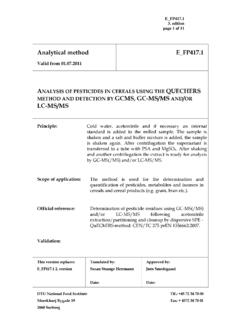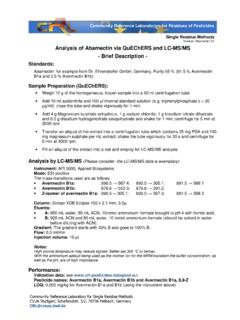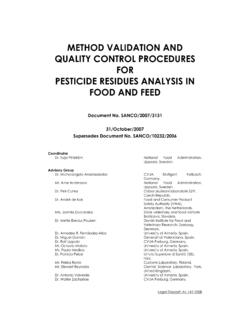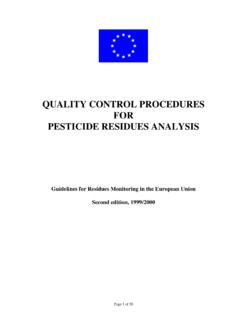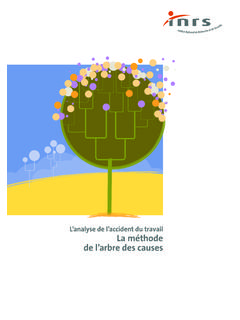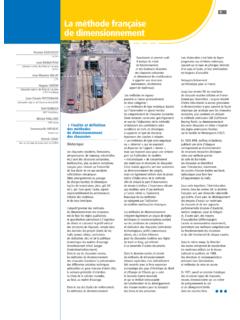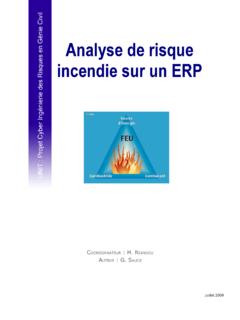Transcription of Quick Method for the LC-MS/MS Analysis of Highly …
1 EU Reference Laboratory for pesticides requiring Single Residue Methods (EURL-SRM) CVUA Stuttgart, Schaflandstr. 3/2, DE-70736 Fellbach, Germany Website: , E-Mail: 1 of 60 Quick Method for the Analysis of numerous Highly Polar Pesticides in Foods of Plant Origin via LC-MS/MS involving Simultaneous Extraction with Methanol (QuPPe- Method ) - Version (March 2015, Document History, see page 58) Authors: M. Anastassiades; D. I. Kolberg; E. Eichhorn; A. Benkenstein; S. Luka evi ; D. Mack; C. Wildgrube; I. Sigalov; D. D rk; A. Barth Content 1 Scope and Short Description 2 2 Apparatus and Consumables 2 3 Chemicals 4 4 Disclaimer 6 5 Procedure 7 Sample preparation 7 Extraction / Centrifugation / Filtration 7 Blank extracts 9 Recovery experiments 9 Preparation of calibration standards 9 LC-MS/MS Measurement 12 Practical Information: Methods currently routinely used at CVUA Stuttgart 13 Method Glyphosate & Co.
2 AS 11 14 Method Glyphosate & Co. AS 11-HC 17 Method Glyphosate & Co. Hypercarb 20 Method PerChloPhos 28 Method 2 Fosetyl and Maleic Hydrazide 29 Method 3 Amitrole & Co. 31 Method Quats & Co. Obelisc R 33 Method Quats & Co. BEH-Amide 35 Method 5 Quats & Co. MonoChrom MS 37 Method 6 Streptomycin and Kasugamycin 38 Method 7 Morpholine, Diethanolamine and Triethanolamine 39 Method 8 TDMs 40 Calibration and Calculations 41 6 Performance Data 45 7 References 46 Note: Changes from V7 to V8 are highlighted in yellow and changes from V8 to are highlighted in turquoise EU Reference Laboratory for pesticides requiring Single Residue Methods (EURL-SRM) CVUA Stuttgart, Schaflandstr. 3/2, DE-70736 Fellbach, Germany Website: , E-Mail: 2 of 60 1. Scope and Short Description A Method is described for the residue Analysis of very polar, non-QuEChERS-amenable, pesticides in foods of plant origin such as fruits (including dried fruits), vegetables, cereals and processed products thereof as well as honey.
3 Residues are extracted from the test portion following water adjustment and the addition of acidified meth-anol. The mixture is centrifuged, filtered and directly analyzed by LC-MS/MS . Various options for the simul-taneous LC-MS/MS Analysis of different combinations of pesticides are provided. Quantification is in most cases performed with the help of isotopically labeled analogues of the target analytes, which are used as internal standards (ILISs). So far available, these ILISs are added directly to the test portion at the begin-ning of the procedure to compensate for any factors having an influence on the recovery-rates such as vol-ume-deviations, analyte losses during sample preparation as well as matrix-effects during measurement. 2. Apparatus and Consumables Powerful sample processing equipment, Stephan UM 5 or Retsch Grindomix GM 300. 50 mL centrifuge tubes with screw caps, : a) reusable 50 mL Teflon centrifuge tubes with screw caps ( Nalgene/Rochester, USA; Oak-ridge, article-no.
4 3114-0050) or b) disposable 50 mL centrifuge tubes ( Sarstedt / N mbrecht, Germany, 114x28 mm, PP, article-no. ). Automatic pipettes, suitable for handling volumes of 10 to 100 L, 200 to 1000 L and 1 to 10 mL. EU Reference Laboratory for pesticides requiring Single Residue Methods (EURL-SRM) CVUA Stuttgart, Schaflandstr. 3/2, DE-70736 Fellbach, Germany Website: , E-Mail: 3 of 60 10 mL solvent-dispenser, for the acidified methanol ( ). Centrifuge, suitable for the centrifuge tubes employed in the procedure ( ) and capable of achieving > 2500 rpm. Syringe filters, Cellulose mixed esters filters m pore size, Polyester filters m pore size (both from Ma-cherey-Nagel, D ren, Germany). Notes: - Significant levels of Perchlorate and Chlorate were detected in the above mentioned polyester filters. Cellulose mixed esters filters were found to be appropriate for these two compounds.
5 For this suitability test take the worst case scenario into account where the filters are clogged by the extracts, not allowing large volumes ( 200 L) to pass. Thus elute only small volumes through the filters ( 200 L). Such clogging was observed using commodities such as industrially milled cereals, pears and pineapples. Furthermore, special attention is required if filters are used to filter diluted extracts as any detected levels in the extracts will have to be multiplied accordingly when cal-culating the levels in the sample. Syringes 2 or 5 mL disposable polypropylene syringes suitable for the above mentioned filters Autosampler vials, suitable for LC auto-samplers, Use plastic vials if pesticides that tend to interact with glass-surfaces are present ( Paraquat, Diquat, Streptomycin and Glyphosate)1.
6 Volumetric flask with stoppers, for the preparation of stock and working solutions. 20 mL; 25 mL; 50 mL, 100 mL glass flasks. Use plastic flasks and stoppers if pesticides that tend to interact with glass-surfaces are present ( Para-quat, Diquat, Streptomycin and Glyphosate). LC-MS/MS instrumentation, equipped with ESI source and appropriate columns, see details in chapters till 1 The list of compounds requiring plastic vessels might not be comprehensive (this remark applies to the entire docu-ment). Such interactions with glass surfaces are typically more pronounced when solutions have low water content and low acidity. EU Reference Laboratory for pesticides requiring Single Residue Methods (EURL-SRM) CVUA Stuttgart, Schaflandstr. 3/2, DE-70736 Fellbach, Germany Website: , E-Mail: 4 of 60 3.
7 Chemicals Unless otherwise specified, use reagents of recognized analytical grade. Take every precaution to avoid possible contamination of water, solvents, sorbents, inorganic salts, etc. Water (deionized) Methanol (HPLC quality) Acetonitrile (HPLC quality) Formic acid (concentrated; > 95%) Acetic Acid (concentrated; >98%) Acidified methanol, pipette 10 mL formic acid ( ) in a 1000 mL volumetric flask and fill up to volume with methanol ( ). Citric acid-monohydrate ( ) Dimethylamine, 40 % by Fluka (article-no. 38940). Ammonium formate ( ) Ammonium citrate-tribasic, anhydrous ( ) Sodium hydroxide ( ) Di-Sodiumtetraborate-decahydrate ( ) Dry ice, technical grade can be used, it should be periodically checked not to contain pesticides at relevant levels. Pesticide Standards, of known purity. EU Reference Laboratory for pesticides requiring Single Residue Methods (EURL-SRM) CVUA Stuttgart, Schaflandstr.
8 3/2, DE-70736 Fellbach, Germany Website: , E-Mail: 5 of 60 Pesticide stock solutions, 1 mg/mL solutions of pesticide standards ( ) in a water miscible solvent ( water ( ), methanol ( ), acidified methanol ( ), acetonitrile ( ) or mixtures thereof). See Table 15 for the conversion fac-tors to be applied between typical purchased standards and analytes and Table 16 for suggested solvents for the preparation of the stock solutions. Use plastic flasks and stoppers if pesticides that tend to interact with glass-surfaces are present ( Para-quat, Diquat, Streptomycin and Glyphosate). Keep in mind that some standards are sold as salts or hy-drates. Some exemplary conversion factors are shown in Table 15. Pesticide working solutions / mixtures, prepared at appropriate concentrations by diluting pesticide stock solutions ( ) of one or more pesticides with water-miscible solvents as required for the spiking of samples in recovery experiments ( ) or for the preparation of calibration standards ( ).
9 See suggestions in Table 16 in the Annex. Use plastic flasks and stoppers if pesticides that tend to interact with glass-surfaces are present ( Para-quat, Diquat, Streptomycin and Glyphosate). Internal Standards (ISs), Exemplary sources are shown in Table 17. IS Stock solutions, 1 mg/mL solutions of ISs ( ) in a water miscible solvent ( methanol, acetonitrile, water or mix-tures thereof). For solvent-suggestions see Table 16 in the Annex. Use plastic flasks and stoppers if pesticides that tend to interact with glass-surfaces are present ( ILISs of Paraquat, Diquat and Glyphosate as well as Dihydrostreptomycin). Keep in mind that some standards are sold as salts or hydrates. Some exemplary conversion factors are shown in Table 15. Notes: - In general the absolute concentrations of the ILIS-solutions are not important as long as the ILIS-concentration in the final extract is high enough to produce a well measurable signal that is not dis-turbed by co-eluting matrix components.
10 Important is furthermore that any content of the native ana-lyte within the ILIS-standard (irrespective whether it was present as an impurity of the purchased standard or whether it was generated in the lab during storage of the ILIS-solution or during sample preparation) is low enough to exclude false positive results or significant influence on quantification. For quantification purposes it is of foremost importance that the ratio between the absolute ILIS amount added to the sample prior to extraction (or to the isolated aliquot of the sample extract) and the absolute amount of ILIS added to the calibration standard solutions is known as it is used in calcu-lations. EU Reference Laboratory for pesticides requiring Single Residue Methods (EURL-SRM) CVUA Stuttgart, Schaflandstr. 3/2, DE-70736 Fellbach, Germany Website: , E-Mail: 6 of 60 IS-working solution I (IS-WS I) for spiking samples prior to extraction, prepared at appropriate concentrations by diluting IS stock solutions ( ) of one or more ISs with water-miscible solvents.
